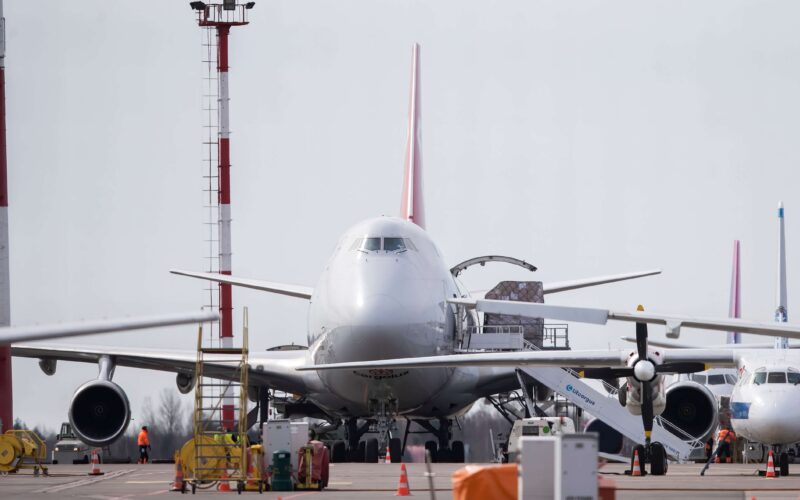The cargo industry is poised to record its second consecutive year of historic revenues and profit levels in 2021. This forecast comes as a result of a stronger focus on dedicated cargo charter capacity and passenger-cargo converted freighters.
Such conditions stem from the cargo capacity shortfall created when the COVID-19 pandemic shut down much of the global economy and crippled fleet capacity.
This in turn impeded 54% of the cargo capacity housed in the cargo holds of passenger aircraft.
Historic air cargo revenues and profits
The combination of a rise in global e-commerce trade, disruptions to international supply chains and decelerated sea freight operations alongside a lack of capacity, has led to an increased reliance on air cargo to fulfill time-sensitive shipments. This constrained cargo capacity has driven up yields and revenues, and subsequently, cargo prices are 4 – 5 times higher than their pre-pandemic levels.
According to IATA, global cargo demand, measured in cargo tonne-kilometers (CTKs), was up 9.4% as of December 2021, compared to 2019 levels. The sector is forecasted to reach a record $175 billion in revenue by the end of 2021, and maintain levels near $169 billion in revenue in 2022.
In 2020, cargo revenues were recorded at historic levels just under $130 billion compared to $100 billion in 2019 which was coupled with a 3% fall in cargo traffic in the same year.
Long-haul cargo carriers
Leading long-haul cargo carrier companies, together with airline carriers, have reaped impressive revenue and profit results during this period. This was achieved despite the disruptions and capacity decline caused by the pandemic. This included a 9% decline in cargo traffic, a figure also seen in 2020.
However, factors such as an increased online consumer appetite and the urgency to transport medical supplies globally while maintaining existing supply chains, have led to a 9% increase in cargo carrier revenues across freight cargo, charter cargo and ACMI cargo transportation. In 2020, profits rose by over 120% compared to the previous year.
In comparison, 2019 came with losses and underperforming profit margins. In 2021, air cargo accounted for more than 33% of airline model revenues. This is twice its former revenue levels which remained at 10-15% in 2019. The focus on dedicated cargo capacity and pax-cargo converted aircraft has never been more crucial for the industry.
Pax-cargo conversions are here to stay
Pax-cargo conversions became a viable alternative for airlines and companies looking to acquire additional cargo capacity without the capital expenditure on new widebody aircraft. These can cost in excess of $150 million per unit. Airline fleets aged 20 years and older, underwent these conversions. However, this was also met with limited conversion capacity due to the rise in global interest for cargo conversions.
For models such as the Boeing 737-800, fully occupied converters can attend to 50 – 60 aircraft slots per year, and slots quickly being filled.
Alongside the increase in demand, widebody aircraft have played a key role for cargo operations owing to the aircraft’s larger payload capacity and cargo-only flights.
In 2020, widebody aircraft were the most utilized, and accounted for about 90% of the passenger fleets meeting the demand for cargo-only flights.
As older aircraft models, such as the 747-400, face a gradual exit from the market, newer and younger models, including the converted 777-300ER, emerge as attractive replacements with greater fuel efficiency and payload capacities. The first 777-300ER began its conversion process in August 2021, and is expected to reach completion within a four-month period. Slots for these conversions are expected to be filled soon.
Fleet and market growth forecast
With a strong demand for cargo, forecasts point to the growth and entry of cargo dedicated models over the next 20 years. Industry manufacturers expect that more than 2,610 freighter deliveries will be required by 2040 to meet demand. According to Boeing, 890 will be widebody aircraft deliveries and the remaining 1720 freighters will be a result of pax-cargo conversions.
By 2040, the industry’s cargo fleet is expected to grow by 70% with a new capacity of approximately 3,435 aircraft, up from 2,010 aircraft in 2019. With the largest cargo market shares and global CTKs being held by Asia-Pacific (32.6%), North America (27.8%), and Europe (22.3%), aircraft deliveries are expected to be focused on these specific countries.
The outlook for air cargo in 2021 is positive, with cargo load factors remaining at 54%, which is roughly 10% above 2019 levels.
There are still backlogs in the supply chain amid high levels of goods trade and production. Cargo data recorded in November 2021 reveals a 1.2% decrease in demand, and lower than usual peak cargo-season volumes. Reports state that the drop was not due to a lack of demand, rather a result of congestion at airports and stagnated logistical operations. However, despite the risks posed by under capacity and low inventory-to-sales ratios, these conditions are still favorable for cargo operations and carriers, particularly as peak cargo seasons such as Christmas draw near.
Demand for dedicated cargo freighters looks likely to increase over the coming decades. Not only is this ‘new normal’ of impressive revenues and profits expected to stabilize, but so will the growing need for dedicated cargo capacity and passenger to cargo conversions.

